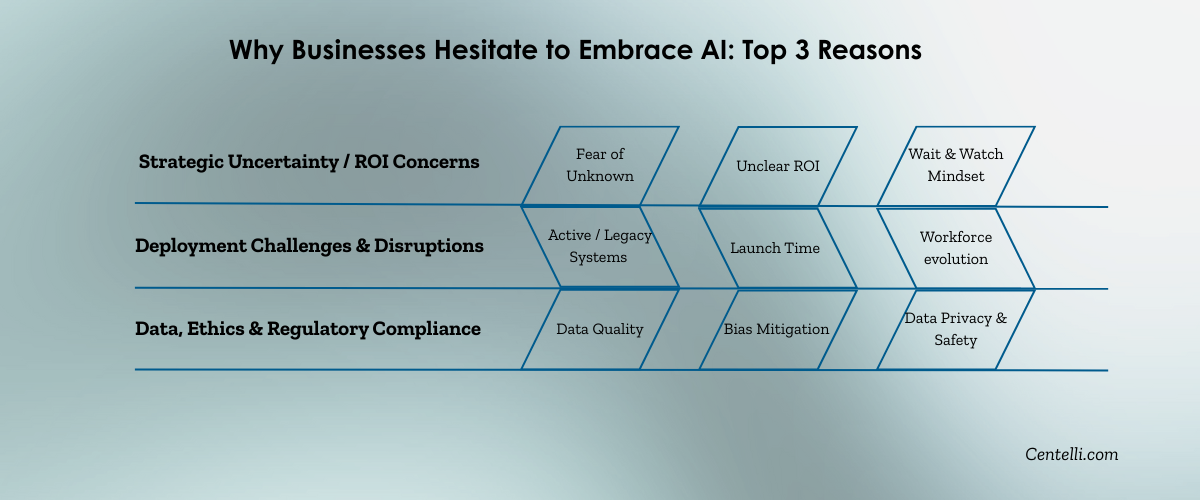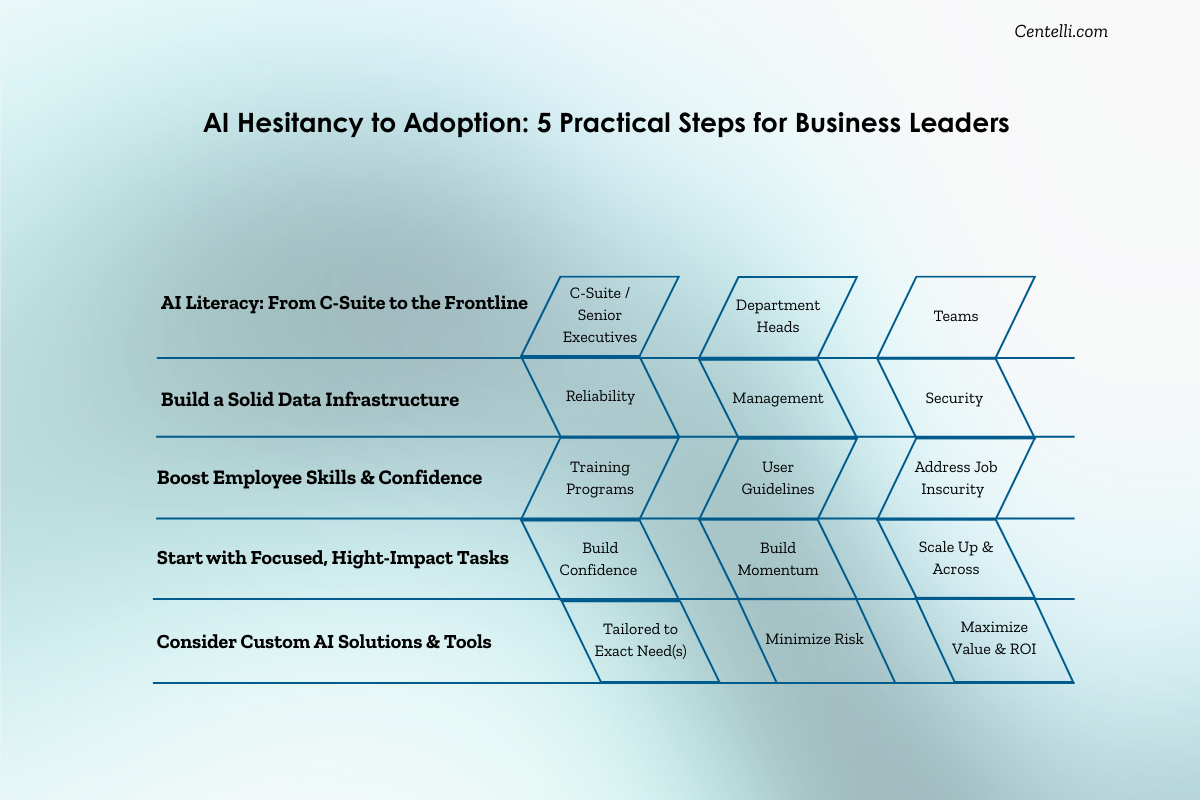
- Artificial Intelligence
- Written By Namita Bhagat
AI Hesitancy in Business: Act Fast or Fall Behind
20-Aug-2025 . 8 min read
Growing at almost 36% per year, the global artificial intelligence (AI) market is likely to reach USD 1.8 trillion by 2030. Significantly, AI-powered automation is also gaining traction across sectors. Yet, AI hesitancy among business leaders is not uncommon!
Operational complexities, unclear ROI, and regulatory concerns continue to be the major barriers to AI adoption. On top of these challenges, AI models are evolving rapidly across text, vision, and voice — widening the scope of applications. Decision-makers must also navigate diverse approaches, from human-centric AI to fully autonomous frameworks, to unlock its benefits while minimizing risk.
In short, figuring out what, why, where, how, and how much of AI deployment can be quite a task.
Top 3 Reasons for AI Hesitancy in Business Explained
So far, larger enterprises have been quicker to adopt AI than small businesses — for obvious reasons like greater financial resources and access to expertise to roll out AI programs. However, they also have their moments of hesitation and indecisiveness.
Let’s explore the key reasons hindering AI adoption, regardless of business size.
1. AI Hesitancy Rooted in Strategic Uncertainty / ROI Concerns
Following strategic barriers may prevent businesses from embracing AI:
- Fear of the unknown: AI is already part of daily life, adding convenience (and even fun!). However, in the workplace, it can be viewed as complex and requiring specialized expertise. Leaders and employees may not always grasp its real strengths or limits. For example, HRs might be concerned about AI bias, while finance leaders may be concerned about forecasting tools, viewing them as AI black boxes lacking transparency.
- Unclear ROI: Even when benefits are understood, the value AI delivers can be difficult to quantify in the short term. Without clear metrics, ROI can be hard to estimate. For instance, it is difficult to link AI-assisted content generation directly to sales impact, while purchase managers may struggle to justify AI-led demand planning until sales are clearly visible.
- Business as usual trap: Some businesses remain reluctant to adopt AI simply because they are seemingly doing well for now. So, they may continue holding on to manual processes, paper-based approvals, and old vendor relationships, or remain stuck in a ‘let’s wait until others prove it works’ mindset.
2. Operational Disruptions When Implementing AI?
Disruptions and downtime are a common worry for every business.
- Deployment time: Longer AI implementation cycles, resource hold-ups, and the extended user training period nobody wants. There’s also the question of whether the solution can scale smoothly across geographies or evolving needs, in a cost-effective way.
- Legacy systems: Some AI and automation tools may not be compatible with outdated systems. Others, however, integrate smoothly into existing workflows, saving organizations from massive fresh investment to replace legacy systems. But rushed rollouts without proper planning and diligence may also end up in wasted resources, project failures, or sub-par results.

- Workforce evolution: Businesses also need to consider the social and cultural impact of AI on their people. Beyond change management, over-automation and loss of human control are key concerns. Apprehensive about potential resistance, a company may prefer a gradual transition to AI-driven workflows.
3. Alignment with AI Regulations and Compliance Landscape
Companies are hesitant when they aren’t clear about responsible AI use.
- Data privacy & safety: AI frequently processes personal, financial, and biometric data. Countries across the world are framing regulations for responsible use and greater transparency. Non-compliance can lead to heavy penalties. However, compliance becomes complex for businesses operating across multiple geographies with differing laws.
- Poor data quality: AI systems should be trained on clean, structured, and relevant data for effectiveness and risk mitigation. If an organization lacks data hygiene, the right infrastructure, or governance, hesitation is natural.
- AI bias & accountability: Regulators and users demand AI transparency. A business is potentially staring at reputational and legal risks if it doesn’t care for bias mitigation and ethical practices. Responsible use and accountability become even more paramount, especially in high-stakes operations like human resources, finance, or healthcare.
5 Steps to Overcome AI Hesitancy and Staying Competitive
Thoughtful hesitation isn’t necessarily a bad thing—it can protect businesses from FOMO and rushed implementation. Here are some practical steps businesses can take to overcome unfounded AI hesitation and make smarter, more deliberate decisions:
1. AI Literacy: From Top to Bottom
Demystify AI for senior leaders first so they fully understand its value and scope for the organization!
- Key decision makers: C-Suite and senior executives should grasp AI’s capabilities, limitations, and potential impact on processes and workflows.
- Cross-functional alignment: Business leaders and department heads must collaborate to align goals, anticipate risks, and ensure smooth implementation.
2. Build a Robust Data Infrastructure
Strong data foundations are essential for reliable and responsible AI.
- Data governance: Build structured, protected, and easily accessible data pipelines for watertight data governance framework.
- Cloud migration: Moving to cloud platforms is good option for many organizations. It enables scalable AI deployment and real-time analytics.
You May Like: Inside Data Management Automation with Digital Workers
3. Start Small, Scale Smart
Begin with focused, high-impact deployments to build AI confidence and momentum for broader adoption.
- Pilot projects: Target manageable, proof of concept use cases such as AI-enabled data management, AI-driven customer support, real-time analytics and reporting, etc.
- Early successes: Quick wins, measurable impact, and clear AI ROI will build confidence for scaling within functions and across the enterprise.
4. Engage Your Workforce
Successful adoption requires employees to understand AI and work with it effectively.
- Reskilling programs: Train staff for AI-enhanced roles to ensure smooth integration.
- Clear guidelines: Formulate rules for data access, use, security, and human oversight to build trust internally and externally.
- AI-human collaboration: Technology shares workloads while improving productivity. Companies must foster employee trust to alleviate fears of job displacement.
5. Consider Custom AI Solutions
Generic AI tools may not always deliver the desired results. Tailored AI solutions offer a clear roadmap, helping overcome adoption barriers as well.
- Tailored build: Automation and AI solutions can be conceived from the ground up or created to augment existing systems.
- Specific value: Bespoke solutions provide benefits aligned to business needs that off-the-shelf AI solutions might miss.
- Bias mitigation: Pre-defined rules guide model training to reduce algorithmic bias while aligning the AI to the organization’s specific requirements.

Reach out to us if you’ve any questions or want detailed info about Centelli’s custom Automation and AI solutions & services.
Finally: Fascinating Facts About Business AI Hesitancy & Adoption
By 2025, nearly 78% of companies worldwide will have adopted AI, with most using it across an average of three different business functions, according to a report.
However, there is a contrasting side — AI hesitancy and slower adoption even now. Surprisingly, in advanced nations as well!
- 63% of American workers used little to no AI in their jobs, with just 16% reporting that AI handles at least part of their work, according to a late 2024 research survey.
Furthermore, it found that AI users are more likely to work in IT, banking, finance, accounting, real estate, or insurance, and in roles that involve data processing.
- 57% of UK businesses haven’t implemented AI-driven solutions to embed compliance into their operations, an industry report reveals.
Surely, we can argue that compliance and cybersecurity sectors are deliberately slower to adopt AI due to their unique challenges. However, experts warn that AI hesitancy in businesses can increase their risk of falling behind.
- Almost all companies invest in AI, but just 1% believe they are at maturity. The biggest barrier to scaling is leaders, who are not steering fast enough, the McKinsey report says.
Regarding ‘maturity,’ the report clarifies that it means AI is fully integrated into workflows and delivers substantial business outcomes.




